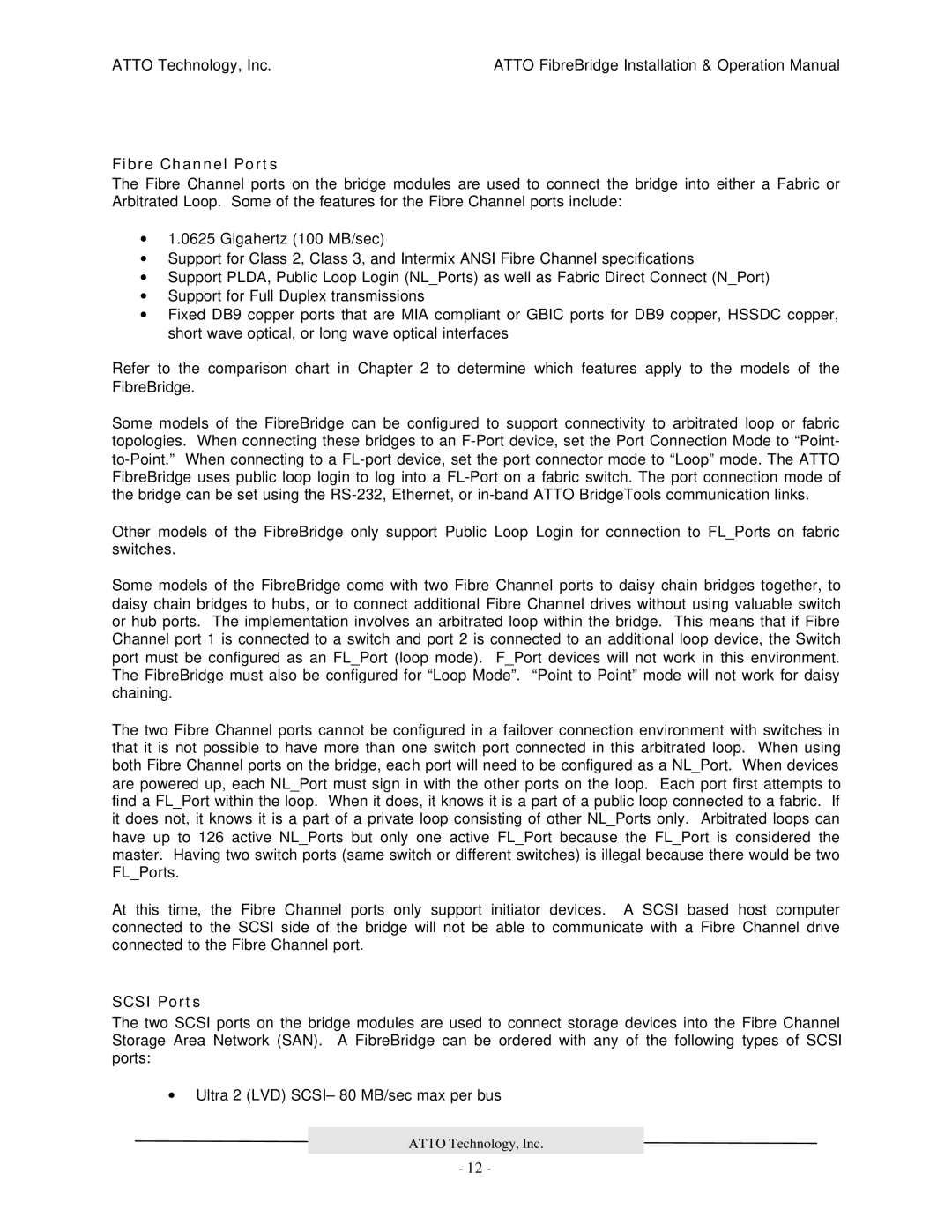ATTO Technology, Inc. | ATTO FibreBridge Installation & Operation Manual |
Fibre Channel Ports
The Fibre Channel ports on the bridge modules are used to connect the bridge into either a Fabric or Arbitrated Loop. Some of the features for the Fibre Channel ports include:
∙1.0625 Gigahertz (100 MB/sec)
∙Support for Class 2, Class 3, and Intermix ANSI Fibre Channel specifications
∙Support PLDA, Public Loop Login (NL_Ports) as well as Fabric Direct Connect (N_Port)
∙Support for Full Duplex transmissions
∙Fixed DB9 copper ports that are MIA compliant or GBIC ports for DB9 copper, HSSDC copper, short wave optical, or long wave optical interfaces
Refer to the comparison chart in Chapter 2 to determine which features apply to the models of the FibreBridge.
Some models of the FibreBridge can be configured to support connectivity to arbitrated loop or fabric topologies. When connecting these bridges to an
Other models of the FibreBridge only support Public Loop Login for connection to FL_Ports on fabric switches.
Some models of the FibreBridge come with two Fibre Channel ports to daisy chain bridges together, to daisy chain bridges to hubs, or to connect additional Fibre Channel drives without using valuable switch or hub ports. The implementation involves an arbitrated loop within the bridge. This means that if Fibre Channel port 1 is connected to a switch and port 2 is connected to an additional loop device, the Switch port must be configured as an FL_Port (loop mode). F_Port devices will not work in this environment. The FibreBridge must also be configured for “Loop Mode”. “Point to Point” mode will not work for daisy chaining.
The two Fibre Channel ports cannot be configured in a failover connection environment with switches in that it is not possible to have more than one switch port connected in this arbitrated loop. When using both Fibre Channel ports on the bridge, each port will need to be configured as a NL_Port. When devices are powered up, each NL_Port must sign in with the other ports on the loop. Each port first attempts to find a FL_Port within the loop. When it does, it knows it is a part of a public loop connected to a fabric. If it does not, it knows it is a part of a private loop consisting of other NL_Ports only. Arbitrated loops can have up to 126 active NL_Ports but only one active FL_Port because the FL_Port is considered the master. Having two switch ports (same switch or different switches) is illegal because there would be two FL_Ports.
At this time, the Fibre Channel ports only support initiator devices. A SCSI based host computer connected to the SCSI side of the bridge will not be able to communicate with a Fibre Channel drive connected to the Fibre Channel port.
SCSI Ports
The two SCSI ports on the bridge modules are used to connect storage devices into the Fibre Channel Storage Area Network (SAN). A FibreBridge can be ordered with any of the following types of SCSI ports:
∙Ultra 2 (LVD) SCSI– 80 MB/sec max per bus
ATTO Technology, Inc.
- 12 -
